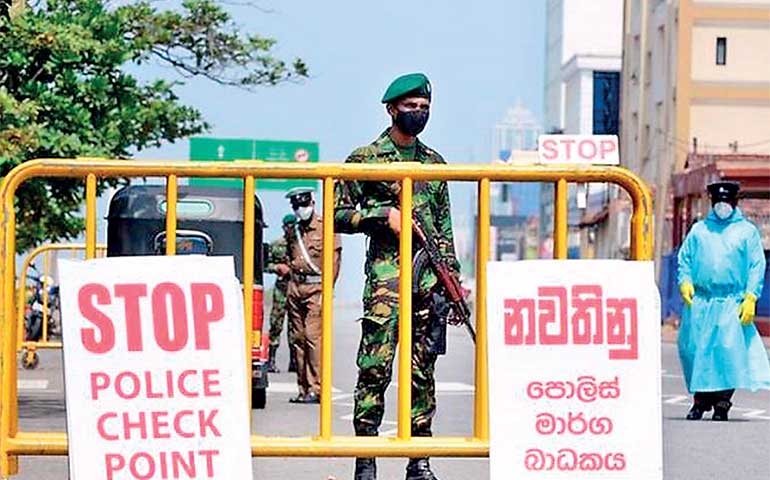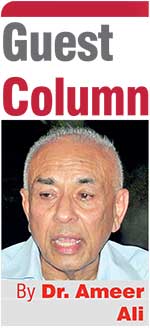Sunday Apr 20, 2025
Sunday Apr 20, 2025
Thursday, 29 September 2022 01:48 - - {{hitsCtrl.values.hits}}

 Politicians are notorious for hiding facts from the public particularly when those facts threaten their popularity. This is what explains the rationale behind RW’s High security zone (HSZ), which more than anything else, symbolises the increasing economic insecurity for the majority of Sri Lankans. He knows very well and does not want to tell the people that economic recovery is going to be disappointingly too tardy and too painful in spite of IMF assistance and reforms. HSZ is no fortress to protect betrayed leaders.
Politicians are notorious for hiding facts from the public particularly when those facts threaten their popularity. This is what explains the rationale behind RW’s High security zone (HSZ), which more than anything else, symbolises the increasing economic insecurity for the majority of Sri Lankans. He knows very well and does not want to tell the people that economic recovery is going to be disappointingly too tardy and too painful in spite of IMF assistance and reforms. HSZ is no fortress to protect betrayed leaders.
There are two sets of factors that make economic recovery more problematic and painful than when it was originally thought. The only criteria on which RW was chosen by his predecessor Gotabaya Rajapaksa (GR) to succeed him as President was the former’s exaggerated economic wizardry.
While GR was blindly pursuing his disastrous alternative path for development endorsed by the two pliant CBSL chiefs, Lakshman and Cabraal, it was RW who, right from the beginning, insisted that there was no solution to the country’s economic woes except to go to the IMF. As the crisis worsened that advice gained popularity and, when RW became the President, he pursued that route in earnest.
The new CBSL Governor Weerasinghe endorsed that approach. In other words, being a firm believer in the efficacy of the ruling neoliberal economic order in which IMF is the chief watchdog. RW and his parliamentary acolytes assumed that the country would be out of the woods after a few months of IMF imposed austerity. The first set of difficulties arise from this approach.
With an exaggerated optimism, staff-level talks with the IMF began in earnest and ended with an agreement, the details of which are not yet presented to Parliament because of their market sensitivity, for a loan of $ 2.9 billion to be given in four instalments.
That loan was made contingent upon (a) Government undertaking demonstrably progressive reforms in fiscal, monetary and foreign exchange areas so that public revenue could be raised, expenditure cut and budget deficit reduced, (b) structural reforms to clean up loss making SOEs and end corruption and (c) agreement with creditors on debt restructuring. How successful that agreement is going to be is yet to be seen.
The CBSL Governor is hopeful that the first tranche of the loan would be made available before the end of December this year. However, when considered against the total dollar needs of the country at the beginning of 2022 when IMF was approached and the scale of assistance required to meet the situation now, the amount of $ 2.9 billion is pittance. Even with the World Bank’s willingness to repurpose funds allocated already for other projects the total demand for dollars far exceeds the supply.
On top of these hangs the future of debt restructuring talks with the country’s creditors. Latest figures show that 34% of the debt belongs to Paris Club members of whom Japan holds the largest share with 19.5%. Of the balance 66% that belongs to non-Paris Club members 52% owes to China and another 12% to India. Given the strained diplomatic relations among the three creditors, how the talks would end is anybody’s guess.
The second set of difficulties arise from outside the country and from the war in Ukraine. It is troubling to note that Putin’s announcement of partial mobilisation and placing Russia’s economy on war-footing, are to prolong the war long and make it deadlier. This is bad news for the global economy, which is already feeling suffocated by supply shortages and supply-push inflation. Food and energy are the two vital sectors that would feel the full impact of the global crunch, and food insecurity is set to escalate and poorer countries would be the major victims.
To confront the inflationary fallout, the US Fed and other central banks are raising interest rates at short intervals. Economists are expecting that the Fed would raise its rate to around 5% by the end of this year. The Bank of England’s borrowing rate has reached 4.5%. Even the Swiss National Bank, after seven years of negative interest rate since 2015, has gone into positive territory with 0.5%.
Other developed nations are following the same trend. All this would take their toll on global economic investment, output, employment and trade. In short, the world economy, including that of China, is facing a significant slowdown.
Small and open economies like Sri Lanka are at the receiving end of this downturn. The apparel industry is already feeling the crunch because of falling export orders. In the manufacturing sector, companies are said to be looking to shift abroad, because of increasing risks at home. The latest survey conducted by the Ceylon Chamber of Commerce and United States Agency for International Development shows increasing pessimism among exporters.
However, what makes recovery particularly more difficult and uncertain for Sri Lanka are additional problems caused by the country’s failure to fulfil promises made to international bodies like UNHRC in relation to human rights, economic crimes, and democratic freedom. These are non-economic issues arising from domestic governance and the ideology on which it is based. Yet, those issues impact the economy if external assistance were to be tied to the shortcomings of the system.
This is where the relevance of systemic change as demanded by Aragalaya takes centre stage in finding a solution to the country’s economic crisis. IMF reforms do not go beyond establishing macroeconomic stability and creating confidence among market players to resume investment and production. However, when the market itself operates in the interest of monopolies and mafias which are linked to centres of political power that in turn are corrupt and promote parochialism, how could an economy thrive to benefit the entire nation?
This is why the solution to the crisis requires a multi-prong approach involving change in the entire system. Neither RW nor his multi-party Cabinet and supporters want to hear about it. Hence the president’s resolve to kill Aragalaya, arrest its activists and erect open security fences like HSZ. That itself signals not easing but hardening economic insecurity in months to come.
The spirit of Aragalaya is not dead although around 3000 of its activists are languishing in jails. With all his precautionary measures, RW is caught between the IMF hammer and an angry public’s anvil. The Maradana protest on 24 Saturday with police spraying teargas on the crowd before arresting around 80 of them, may be a dress rehearsal for the next phase of Aragalaya.
Given this situation, the only recourse open to any political group trying to capture power is to tell the people the whole truth about the complexity of problems confronting the nation, explain the need for a multi-prong approach to overcome them and seek fresh mandate to tackle the challenge. It is heartening to read from reports that the NPP Leader is now speaking publicly about specific proposals along that direction. His proposal to introduce structural changes to the market for example is one such proposal. More has to come to convince the voting public.
Sooner the country goes to the polls better for its future. The hackneyed theme of protecting Buddhist Sasana and Sinhala hegemony may not work this time, because the saffron army and their demagogic foot soldiers who were leading that campaign last time stand discredited and condemned by the sufferings their heroes had caused in the name of Buddhism.
(The writer is from Murdoch Business School, Murdoch University, Western Australia)
Discover Kapruka, the leading online shopping platform in Sri Lanka, where you can conveniently send Gifts and Flowers to your loved ones for any event including Valentine ’s Day. Explore a wide range of popular Shopping Categories on Kapruka, including Toys, Groceries, Electronics, Birthday Cakes, Fruits, Chocolates, Flower Bouquets, Clothing, Watches, Lingerie, Gift Sets and Jewellery. Also if you’re interested in selling with Kapruka, Partner Central by Kapruka is the best solution to start with. Moreover, through Kapruka Global Shop, you can also enjoy the convenience of purchasing products from renowned platforms like Amazon and eBay and have them delivered to Sri Lanka.
Discover Kapruka, the leading online shopping platform in Sri Lanka, where you can conveniently send Gifts and Flowers to your loved ones for any event including Valentine ’s Day. Explore a wide range of popular Shopping Categories on Kapruka, including Toys, Groceries, Electronics, Birthday Cakes, Fruits, Chocolates, Flower Bouquets, Clothing, Watches, Lingerie, Gift Sets and Jewellery. Also if you’re interested in selling with Kapruka, Partner Central by Kapruka is the best solution to start with. Moreover, through Kapruka Global Shop, you can also enjoy the convenience of purchasing products from renowned platforms like Amazon and eBay and have them delivered to Sri Lanka.